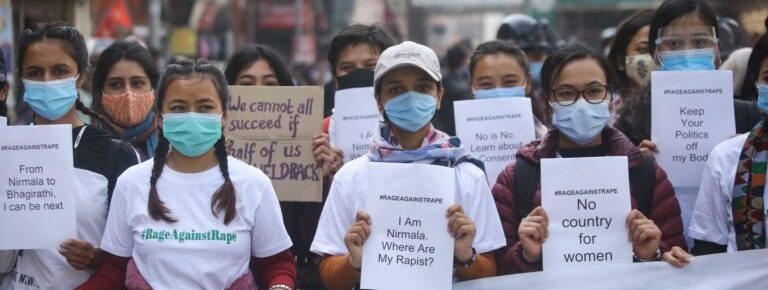by B Nimri Aziz, Feb 17, 2021 Counterpunch.org
Boisterous, almost frivolous rallies and counter-demonstrations representing Nepal’s numerous political factions have become commonplace across the country for 2 months now. They continue with neither a clear aim nor signs of a resolution.
Last Friday, partisan rallies were eclipsed by more earnest protests from another quarter. These were women-led marches over negligence, insults and threats to their personal and legal status.
Whatever gains her women made in framing Nepal’s 2015 democratic constitution, whatever pressure they exert on authorities to solve the murder of girls and members of marginal castes, however many women fill posts in the party and government, despite having a female president—Nepal’s women find that in the end, they have to pour into the streets to cry for equity and justice.

February’s 12th sizable, well-organized Darbar Women’s March was precipitated by a Department of Immigration proposal that would restrict women under 40 traveling outside the country. Perhaps intended as a measure to protect migrant women workers from exploitation by foreign bosses, in the absence of government reforms to prosecute domestic abusers and address joblessness at home, the gender-biased proposal aroused shock and brought women into the streets. (While the number of women migrant laborers is unknown, Nepali men employed overseas are estimated at 4 million–possibly up to 7 million– an alarming figure in a population of 28 million.)
The anger of young adults had already peaked concerning police laxity over the rape and murder of girls, starting with a notorious 2019 case where no suspect has yet been identified, and aggravated by a more recent similar case of police inaction.
A further motive behind women’s street action is surely impatience with protracted power games played out in mass rallies in support of opposing party leaders summoning followers to endorse their competing claims on the prime-ministership.

In the 2018 election, when the NCP (Nepal Communist Party) coalition of Maoists and Communists won a historic majority, inter-party bickering was expected to end. Basic reforms would be implemented and Nepal would become a proud democracy. Communist Party leader K.P. Oli was named prime-minister with Maoist leader P.K. Dahal, (the united) party chairman. Some questioned how long this arrangement could hold. Indeed, that victory has become tainted by increasing corruption, by suspicion of secret ‘arrangements’ with India, by growing unemployment, and by disarray resulting from Oli’s neglect and ineptitude around the Covid pandemic.
A foreign policy difference brought matters to a head in December: the Prime Minister, impatient with parliament’s opposition to India’s military treaty (MCC– Millennium Challenge Corporation) with the U.S., unilaterally dissolved Nepal’s House of Representatives. His endorsement of that treaty, opponents argue, effectively sidelines Nepal and threatens its relationship with China.
Oli’s move, considered unconstitutional, led to cabinet resignations but was met by silence from Nepal’s president, Bidhya Devi Bhandari. Although legally bound to neutrality and positioned to call an election, Bhandari remains a firm ally of the prime minister.
While Nepal’s Supreme Court deliberates the matter, undiminished rallies are the butt of press jokes: e.g. a cartoon where Oli and Dahal, each lined up with their indistinguishable and interchangeable flocks ask: “Ok; shall we bet one more each”. Other parties jumping into the fray include monarchists who support restoring the kingship (dissolved in 2008, after a 200-year rule).
“That’s impossible”, one longtime Nepali leftist emphatically retorts to rumors of a restored monarchy. Meanwhile a dismayed expatiate watching those tournaments from the U.S. notes: “It could not be worse than what we have now in Nepal”. She’s referring to mismanagement, unemployment, corruption and kleptocracy after 13 years of disappointing democracy.
And how can tens of thousands of supporters reach the cities from the countrywide to support one contender over another? “They are paid –their hotels and air fare–to join”, comments one cynic. Party coffers seem well stocked for these indulgences.
Despite political turmoil and an almost absent government, the nation has thus far escaped devastation from the global Covid pandemic. To date, whereas cases of infection are high, approaching 275,000, hardly 2,000 deaths have been recorded (comparable to Denmark with one fifth of Nepal’s population). And while food prices have shot up in Nepal, somehow, beyond the elite, and despite unquestionable hardships, people are managing relatively well.
Villagers who took up residence in Kathmandu and other cities in recent years, living off remittances from sons abroad, are now returning ‘home’ to cultivate their abandoned fields. A recent visitor to his homeland unable to return to the U.S. due to lockdown restrictions praises his compatriots’ resourcefulness, noting their return to ‘pahari’ or hill people’s diets of grains and herbal teas, local fruits and vegetables which they had abandoned believing them inferior to less nutritious rice and produce imported from India or China.
If politicians were less driven by their personal ambitions, this is surely a golden opportunity to harness the proletariat they pretend to represent and move Nepal along a new self-sufficient path.

